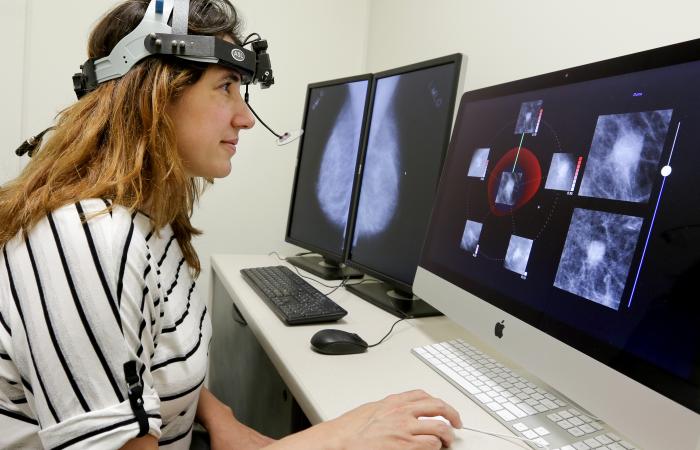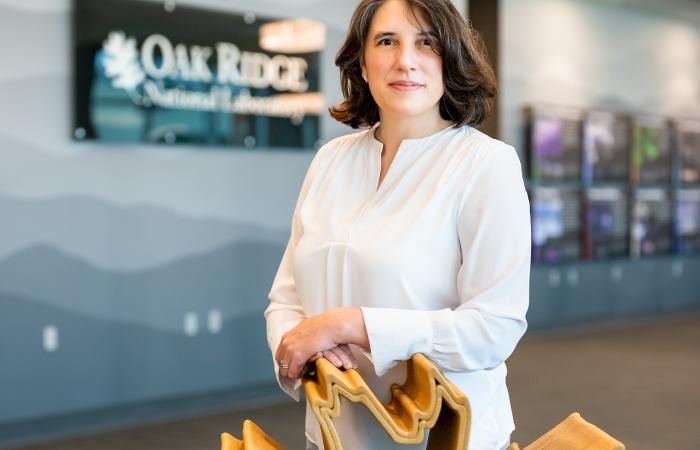-

Sophie Voisin, an ORNL software engineer, was part of a team that won a 2014 R&D 100 Award for work on Intelligent Software for a Personalized Modeling of Expert Opinions, Decisions and Errors in Visual Examination Tasks. Credit: Jason Richards/ORNL, U.S. Dept. of Energy
-

Sophie Voisin is a software developer at Oak Ridge National Laboratory. Credit: Carlos Jones/ORNL, U.S. Dept. of Energy
-

Sophie Voisin, an ORNL software engineer, was part of a team that won a 2014 R&D 100 Award for work on Intelligent Software for a Personalized Modeling of Expert Opinions, Decisions and Errors in Visual Examination Tasks. Credit: Jason Richards/ORNL, U.S. Dept. of Energy
-

Sophie Voisin is a software developer at Oak Ridge National Laboratory. Credit: Carlos Jones/ORNL, U.S. Dept. of Energy
Cameras see the world differently than humans. Resolution, equipment, lighting, distance and atmospheric conditions can impact how a person interprets objects on a photo. For Sophie Voisin, a software engineer at the Department of Energy's Oak Ridge National Laboratory, images can reveal what human eyes can't see, giving a different perspective to understanding how the world changes day to day.
Technically, Voisin's work at ORNL is all about images - enhancing, improving, analyzing and exploiting high-altitude and low-altitude imagery and full-motion video from drones. Each day, satellites use cameras, referred to as sensors, to view what is happening all over the world. The volume of images captured daily is enormous. This is where Voisin's true technical passion comes into play.
"I like to code. I like the technical side of programming algorithms to find the sweet spot to apply the latest and greatest research to real problems," said Voisin. "I can immediately see if changes to my algorithm are applied correctly."
Maintaining speed, accuracy
Voisin has been nurturing algorithms for the past seven years to process increasingly larger collections of imagery faster. What started out as one small application has grown to 12 projects; she now leads a team of 32 as the primary investigators. The team aims to use software development, scientific research and software engineering to figure out which images show changes to the landscape that may be of interest to the U. S. government. By letting computers sort through the initial mounds of pictures and flag certain ones, analysts can then review and interpret which images actually have value to decision makers.
Image processing is not an easy process. The sheer number of raw images continues to increase as sensors capture more snapshots of the world. Processing each image increases its size two- or threefold. With large file sizes making up huge datasets, high-performance computers offer the best chance of processing images at the speed needed to make relevant decisions. Leveraging the speed of ORNL's high-performance computers, Voisin's team also strives to provide high confidence in the accuracy of results.
Throughout the last half decade, Voisin adapted and maintained applications as hardware changed and graphics cards increased in capability. To prevent the algorithm from breaking, Voisin and her team test new hardware before it goes live to ensure continued flow of information.
Algorithms make the difference
Though imagery is imagery, Voisin said, it is the size of the files that differ. Since embarking on a doctorate program in computer science and image processing, she has worked on the beamline at the High Flux Isotope Reactor, a DOE Office of Science user facility, on medical imaging for mammograms and now geospatial images. For her, the challenge of developing and tweaking algorithms for different types of images is the exciting part.
"National security work is a different pace than other industries. I can test algorithms to fit the data and then upload it to the project," Voisin said. But to apply machine learning algorithms to the data, computer scientists need training data.
Training data helps the model learn what to look for in an image. A new algorithm may not know the difference between a box truck and a house, as both may appear as a square shape. Computer scientists write algorithms to detect certain features and then train the algorithm to distinguish among "square shapes" and determine which needs to be flagged for further analysis.
Continuing to learn from colleagues
East Tennessee has been home for Voisin and her family since moving to the United States from France more than a decade ago. She and her husband found opportunity at ORNL to work on fascinating projects and make an impact with applied research.
"I came to the lab for the research opportunities, but the day-to-day work is about the people you work with, and I'm thankful for working with a fantastic team," Voisin said. "Having good relationships with my colleagues pushes me to become a good mentor as I'm still learning a lot from others."






